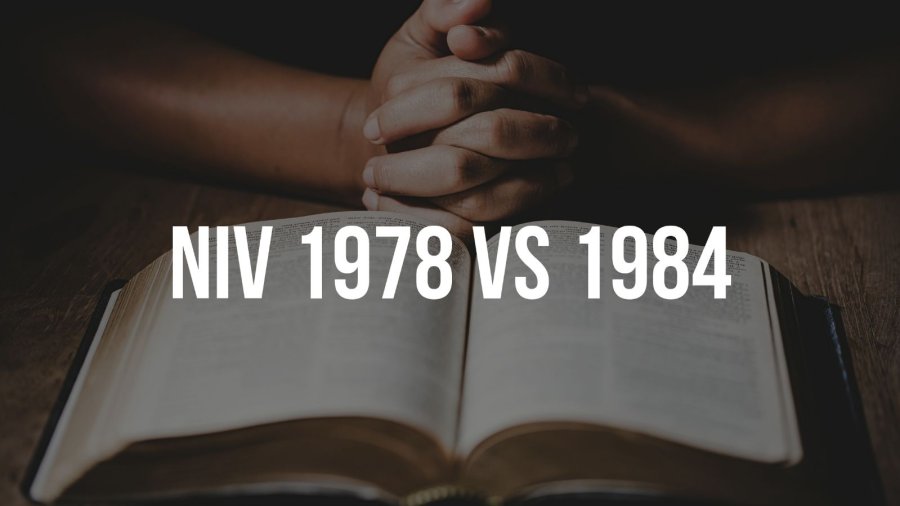The New International Version Bible was first released in 1978 and has been a best-selling translation worldwide. The New York Bible Society and more than a hundred other non-denominational scholars created this popular English Bible. It’s a thought-for-thought and word-for-word translation viewed as an accurate and smooth-to-read version of the Bible. The NIV Bible was subject to some updates in 1984. So, what is the difference between the NIV 1978 versus the 1984 version?
Overview of the NIV
Businessman Howard Long wanted to create an English Bible translation that would be readable for everyone. He shared his concerns and desire to create a new Bible version with his friend and pastor, Reverend Peter DeJong. After several years of trying to persuade their denomination, the Christian Reformed Church created a committee to study the need in 1957. This committee comprised a team of evangelical Bible scholars called the Committee on Bible Translations (CBT). They aimed to safeguard and keep updated on any work on the NIV Bible. It took several decades, but eventually, a non-denominational group of over 100 scholars met in Chicago to strike a deal and begin working on the NIV. In 1968, the New York Bible Society eventually took over the primary role in the NIV project development and continuation, and the New International Bible version was born.
A New International Version of the New Testament was published in 1973, and the entire NIV Bible version was released in 1978. A United Kingdom NIV version was also released that same year.
Over time, the New York Bible Society changed to the International Bible Society in 1988 and Biblica in 2009. Today, Biblica maintains the copyrights to the New International Version and still publishes it for their ministry. Zondervan Publishers has commercial publishing rights in the United States.
Although the process seems long, those in the know say the process was purposely long to ensure the translation’s readability and accuracy. Independent teams of scholars studied every book of the Bible made up of
- 2 lead translators
- 2 consultants
- 1 English consultant
The original goal of those who worked on the NIV Bible in 1965 was to ensure that the translation was always Biblically accurate and written in readable English. Editing and updating continue as the English language evolves.
It’s estimated that over 450 million copies of the NIV Bible have been sold worldwide, making it one of the most-read English Bibles in the world.
Translation differences
Since 1978, the NIV Bible translation has been revised twice (1984 and 2011) due to Biblical scholar input, English language changes, and archeological discoveries. The translators sought to increase accuracy while maintaining the meaning of what the ancient texts said.
The NIV had minor revisions in 1984 and then again in 2009. Today’s NIV has 95% of the same words as the 1984 edition. There are changes in how the version expresses the meaning. Today’s version is more up-to-date for modern readers. Other differences include
- Vocabulary choices
- Verb tenses
- Gender-inclusive language
- Philosophy
Vocabulary
The 1984 NIV Bible changed some of the vocabulary of the 1978 translation. The updates were to make this version more readable, consistent, and accurate with the evolution of the English language.
Verb Tenses
The 1984 NIV changed the verb tenses in the translations to improve their readability and clarity for modern readers. These changes included
- Present participle verb forms
- Present tense
- Past tense
Gender Neutral language
The biggest change in the 1984 NIV translation was using gender-inclusive language. The translators desired to appeal to both men and women for a better general understanding of the original texts. This changed passages in the 1979 NIV translation of the entire Bible using gender-distinct language.
Philosophy
The 1984 NIV translation resulted from years of insights and feedback from readers. Translators hoped to hear readers’ concerns while maintaining the reliability and accuracy of the NIV translation.
Verse comparisons
The NIV Bible translation is criticized for removing certain words. One complaint is that the words “Holy Ghost” have been replaced with “Holy Spirit.” However, many scholars suggest that the Holy Spirit is more accurate than the Holy Ghost. The 1978 and 1984 NIV Bible versions are based on the original Greek, Aramaic, and Hebrew texts. These versions are considered readable and accurate. There have been some updates due to archeological findings, new scholarly studies, and changes in the English language. These have kept the meaning the same but are said to make the version better for today’s readers.
Examples of differences in verses from 1978 and 1984
Psalm 23:1
The 1978 NIV translates, Psalms 23:1-The LORD is my shepherd, I lack nothing.
The 1984 NIV translates Psalm 23:1- The Lord is my shepherd, I shall not be in want”.
Genesis 1:27
The 1978 NIV translates Genesis 1:27-So God created mankind in his own image, in the image of God he created them; male and female he created them.
The 1984 NIV translated Genesis 1:27-So God created man in his own image, in the image of God he created him; male and female he created them.
2011 differences
The New International Version was updated once again in 2011. The main differences between the 1984 edition and the 2011 translation include
- Gender-inclusive language- The 2011 translation of the NIV used words such as “people” instead of men and women.
- Text updates-Recent manuscript discoveries and Biblical studies affected textual changes.
- Language updates-In the most recent NIV translation, some of the language has been changed to more contemporary terms while maintaining Biblical accuracy.
- Footnotes- The latest translation added footnotes to explain passages and add context.
- Numbering verses- The 2011 translation has been updated with different verse numberings to complement the Greek and Hebrew texts.
Other edits
Some suggest that the 2011 NIV is simply a revision of the 1984 NIV. Scholars agree that whenever translations are made between languages, decisions must be made about the meanings of the original text. Because of this, sometimes there is more than one meaning. For instance,
- The 2011 version eliminates some gender-neutral language, such as using the word “mankind” or “man” instead of “human beings.”
- The 2011 NIV uses “flesh” instead of the 1984 use of “sinful nature.”
- The 1984 NIV translates Romans 8:4 as saying that Jesus’ sacrifice satisfied the “righteous requirements” of the law, but the original Greek word for requirements is in the singular rather than the plural tense.
Controversy
All Bible translations are criticized to some degree. Critics of the NIV preferred something other than the meaning-for-meaning approach instead of the word-for-word approach. Others condemned the modern versions. In 1997, there was a controversy over the NIV incorporating gender-neutral terms. One individual showed their disagreement with the translation by putting holes in several NIV Bibles that looked like bullet holes and then mailed them to the Biblica.
In an effort to stop the attacks, Zondervan released a press statement saying the gender-inclusive language was used to help explain the original meaning of the ancient texts in line with the English language. For instance, they said, in Hebrew, the word “adam” means “human being” rather than “man,” so it was more accurate to use the word “person” for the translation. Due to continued outrage, the 1984 edition was kept, and a new version called Today’s New International Version (TNIV) was created with gender-neutral additions.
Today
Today, the New International Version of the Bible is popular. In 2023, it was one of the best-selling English versions worldwide. But it’s lost some of its popularity due to the creation of the English Standard Version. Besides this, some suggest the popularity of the New Living Translation and the Christian Standard Bible translations may push out the NIV.
Every year, the Committee on the Bible Translation Committee (CBT) meets to consider scholars’ suggestions for changes to the NIV. These changes are voted in and then archived for the next NIV edition. This 40-year-old committee comprises 15 self-governed members from diverse denominations who desire to protect the NIV from specific agendas or biases. Although Biblica holds the copyright, only this group can revise or edit the NIV, so no commercial group or publisher makes decisions about how the NIV is translated. Their goal is to keep this translation readable and accurate. The CBT believes that each generation is entitled to be able to read and understand God’s word in their language.
If you’re looking for an accurate, readable Bible translation, look no further than the New International Version. It’s a tried-and-true translation that has stood the test of time. Read by millions of readers over the decades, the 1978, 1984, and 2011 versions maintain Biblical accuracy.

